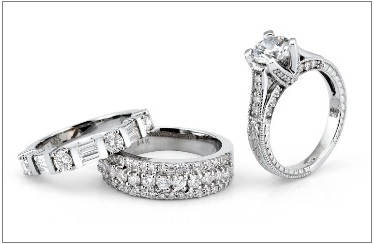
The elusive engagement ring has been a hot topic among budding brides and grooms for decades. Hours upon hours can be spent on websites searching for trends, looking through bridal magazines for inspiration, and going into stores to try on different styles. Major research is often conducted to learn about the 4Cs and how to choose the best diamond possible for their budget. All in search of the perfect engagement ring diamond, shape, size and setting. This blog will focus on ring settings and how you can guide your customers toward the right diamond ring setting for them.
Settings may seem of secondary importance to the diamond itself but the setting can really make a ring. As said by TheKnot.com “Although the stone can account for up to 90% of the cost of the ring, the setting is what defines its look and showcases the stone to its best advantage.” Some settings are timeless and never go out of style while others may look dated in a few years. Certain settings are designed for maximum exposure of the gem, allowing a lot of light to pass through, creating a blinding sparkle. Others can be more understated for those people who are minimalists and love dainty jewelry, even for engagement rings.
Let’s look at some more commonly used diamond ring settings, how they have trended over the years and which celebrities wear them.
Prong
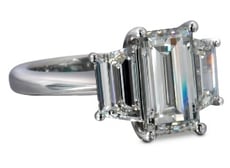
“You might be surprised to learn that even when it comes to that perfect engagement ring, there is no real gold standard, so to speak. What is a fact though is that the diamond solitaire in Tiffany & Co. prong setting is today considered the classic engagement ring.”- Luxury Insider
So how can you easily explain what a prong setting is to your customers, and what they should be looking for in a pronged ring? Start by explaining that in a prong setting, the diamond is held in place by prongs, or claws, surrounding it. This is the most popular setting, perfected by Tiffany, as their signature setting is a scientifically developed and trademarked version of a prong setting.
A four-prong setting is often used but larger, more expensive diamonds are usually set with six prongs. Prongs can be pointed, rounded, flat or V-shaped. This style of setting shows off the dazzle and radiance of the diamond without overshadowing it, as the minimal amount of metal allows the greatest expanse of light to pass through it.
The pronged engagement ring conveys an image of simplicity and power at the same time. As celebrity can impress many customers, you can let yours know that Mila Kunis wore a pronged engagement ring before she married Ashton Kutcher in the summer of 2015.
Channel
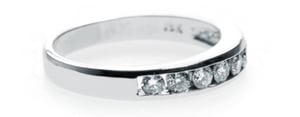
Many customers might know what a channel setting looks like, but not by name. In this type of setting, diamonds of the same size are lined up next to each other and set in a groove between two strips of precious metal, but with no visible metal between the stones. The almost invisible setting creates the illusion of a band of diamond so it’s a great solution for making a smaller diamond appear bigger.
The channel setting is quite fitting for eternity bands, stackable bands and as embellishment on the side of the main diamond in an engagement ring. The channel setting was popular in the 1980’s and though its popularity has declined slightly, it’s making a comeback today. This is what British star Cheryl Cole wore as her wedding band.
Bezel
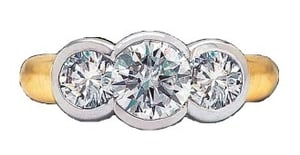
Often, customers might recognize the bezel setting from something their grandmothers might have once worn. In a bezel setting, the diamond is placed in a continuous groove in the precious metal. The edges of the metal are then closed over the edge of the diamond to hold it into place. Normally, only the upper portion of the diamond — from the girdle up — is visible. It has a very contemporary feel to it and the diamond is completely secured inside the setting, making it a practical choice for active, on-the-go types.
As older trends often make a comeback, the bezel’s modern appeal is a revival from a time of earlier jewelry settings. The bezel was one of the only ways that diamonds and precious jewels were set until the early 1900’s when advanced jewelry setting techniques emerged, allowing for more exposure of a diamond's sides. The bezel made a return appearance in the 1990’s and has remained prevalent ever since. It’s a close second to the prong setting in popularity and was the engagement ring type that actress Leighton Meester chose.
Tension

Customers may or may not be familiar with tension settings as it’s one of the more unusual, bold diamond styles. For someone looking for a unique and modern fashion statement in their diamond setting, the tension setting is a great option.
In a tension setting, the diamond is held in place by the tension created by the ring’s band. This setting requires a sophisticated technique and the use of special alloys to enable the metal to retain its shape. Sometimes this distinctive style is referred to as a suspended or floating setting as the diamond appears to be almost hovering above the setting itself.
The tension style was developed in the 1960’s by jeweler Fredrich Becker and was vastly improved upon in the 1970’s by jewelry artist Walter Wittek, who even copyrighted it.
Though it may look like the diamond is precariously placed, a good tension setting is just as secure as any other setting. The tension setting has been called “The art of reduction” in regard to its modern and minimalist appearance. It’s a truly unique look that evokes a chic and exclusive feel.
Pavé
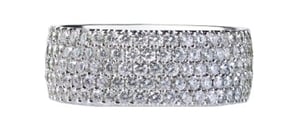
Many customers are familiar with the pavé setting. This setting generally uses smaller diamonds that are set tightly together to create a “paved” effect, and it appears as if there’s no metal between the diamonds.
This style dates back to the Victorian era and gets its name from the closely held together cobblestone paved streets of France. Pavé is suitable for smaller diamonds or diamonds with less brilliance, as the sparkle from the other tiny diamonds brings out the center diamond’s radiance. As a diamond jewelry retailer, you can suggest this to customers whose budgets are likely to result in a smaller or lesser quality diamond as a way to enhance the overall beauty of the ring.
Pavé matches well with large diamonds too, as the setting highlights the other diamond type. Natalie Portman wore an engagement ring made of eco-friendly recycled platinum and conflict-free diamonds. Her glamorous ring featured a 4-carat round center stone surrounded by a double halo of pavé diamonds.
Bar
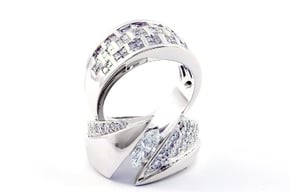
Some customers may know what a bar setting looks like, but not what it’s called. Similar to a channel setting, in a bar setting each stone is held in place by a long thin bar that is placed between the two diamonds. Often, it’s a single diamond that is held in place between the two bars. This style exudes a contemporary look that gives off more sparkle than a channel set diamond because the open sides flood the diamond with light.
Conclusion
Encourage your customers to think about how the diamond and the setting will complement each other and the wearer. Once the perfect diamond has been chosen, present different options of setting that will work best with that diamond and your customer's personal preferences. Be sure to mention the wedding ring at this time too, so that the customer has confidence that the two rings will work well together and hopefully purchase both at the same time.


 RapNet Blog
RapNet Blog